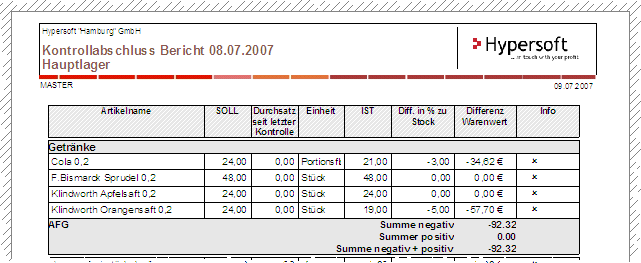final inspection report
The final inspection report shows you all the differences between the theoretical stock and the actual stock that results from your inspection entry. Use Best Practice: Book differences as consumption to use this report effectively.
In the list of control entries, you can call up detailed information on the respective entry via a button. The type of throughput calculation used at the time of control entry is displayed in the right-hand area. With the Show only recorded items option, you can restrict the analysis to the items actually recorded.
The alternative layout with VK valuation (sales price valuation) calculates the sales value of the items and creates totals per storage location as well as grand totals. You can also select a different price level to be used when calculating the differences. The sales difference is determined on the basis of the selected price level and the missing bookings.

The differences are shown according to valuation groups and calculated on the basis of the number of items and the cost of goods sold. The difference is displayed in number, cost of goods and lost sales. The lost turnover is particularly revealing if the differences indicate that the goods were probably sold but not booked.
Final inspection report in print format
With the option Layout with sales price valuation, you can use the sales price instead of the contribution margin (DEK) for the evaluation. This is particularly useful if the whereabouts of the goods could be explained by an unbooked sale. Patterns that indicate repeated unauthorised cash withdrawals can be identified on the basis of the sales value. The printed report generates totals per product group and a cumulative total at the end.

The throughput calculation reflects the consumption by cash postings. The throughput is adjusted for inputs and outputs, productions and transfers, so that it only takes into account the cash postings made. The "daily throughput" is then calculated from this. Here the sum is divided by the number of days since the last control recording.
The throughput calculation shows consumption through cash bookings and is adjusted for incoming and outgoing goods, productions and transfers. This means that only the actual cash bookings are taken into account. The daily throughput is calculated by dividing the total by the number of days since the last check. If no check has yet taken place, the throughput cannot be calculated. A correct throughput calculation is only possible with controls of full days.
If a check is carried out during operation, the throughput cannot be calculated correctly as the stocks are recorded on a daily basis. Although the throughput is initially calculated correctly, it is incorrectly calculated retroactively up to the last TTA (daily closing) during the next check. As a result, the throughput calculation covers a different period than that stated in the final inspection report.
Control correction procedure and final control report
If you check an item that has already been checked again on the same day, e.g. to correct an incorrect entry, the stock is posted correctly. However, the value recorded first remains in the final inspection report in order to prevent manipulation.
Back to the parent page: Reports and lists of the Stock ReporterStock Reporter